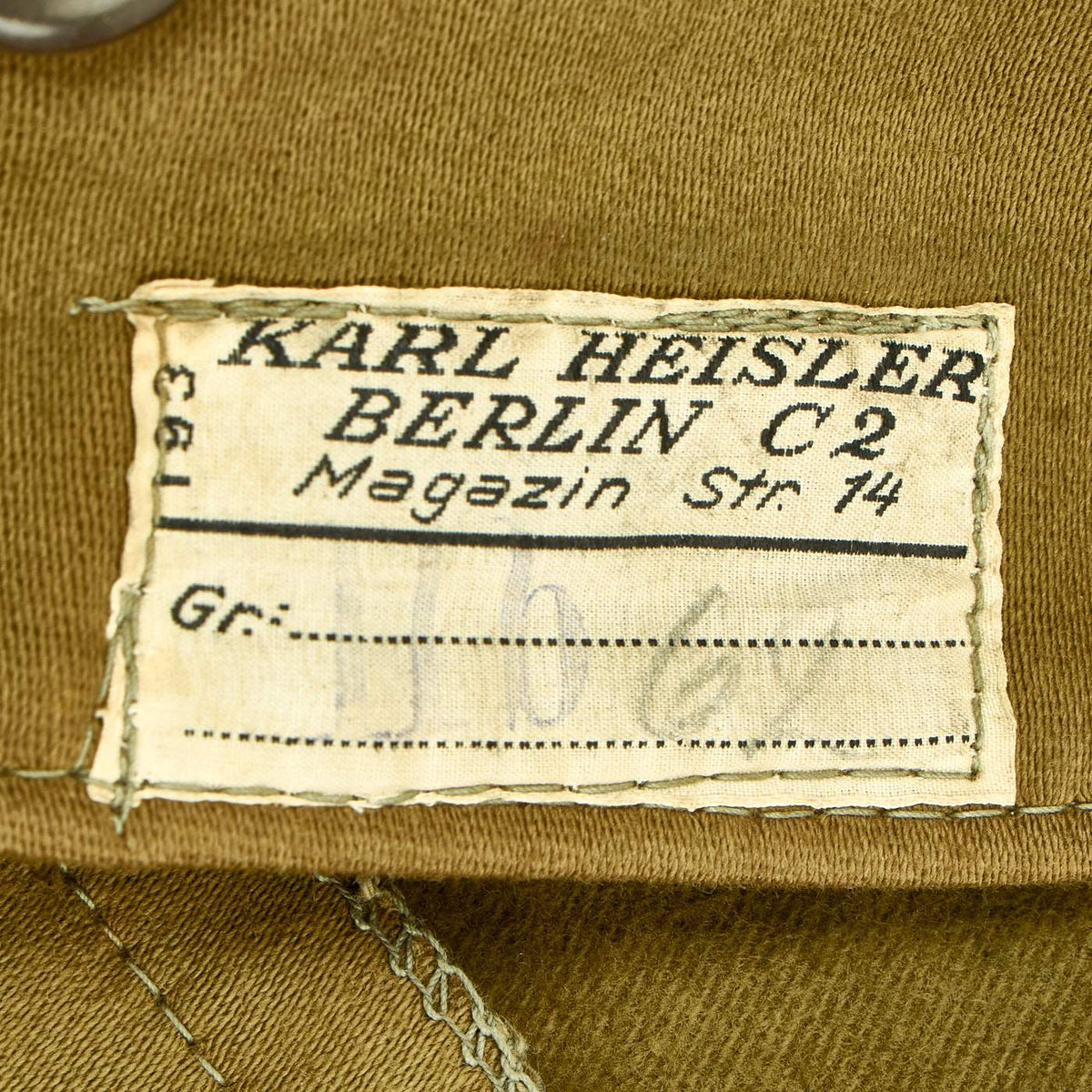Original German WWII Fallschirmjäger Paratrooper Training Jump Smock Suit by Karl Heisler of Berlin Original Items
$ 1.495,00 $ 373,75
Original Item: Only One Available. Mint like new condition World War Two German Fallschirmjäger Training coverall smock. This is referred to as a Schleifanzug or “dragging smock” for paratroop training. It is produced in tan heavy canvas with soft internal lining. All of the buttons are present and marked PRYM. There is a Karl Heisler of Berlin maker tag on the closure seam which is size stamp II b. Overall condition is excellent.
Approximate Measurements:
Collar to Shoulder: 7.5”
Shoulder to Sleeve: 25”
Shoulder to Shoulder: 19.5”
Chest Width: 17.5”
Waist Width: 16”
Hip Width: 18”
Front Length: 57.5”
During the German invasion of Poland in September 1939 the Fallschirmjäger were sent to occupy several airfields between the Vistula and Bug rivers.
The first opposed airborne attacks occurred during the Norwegian Campaign, first during the initial invasion when Fallschirmjäger captured the defended air base of Sola, near Stavanger. The Fallschirmjäger also had their first defeat in Norway, when a company was dropped on the village and railroad junction of Dombås on 14 April 1940 and was destroyed by the Norwegian Army in a five-day battle.
On 10 May 1940, the Fallschirmjäger performed a successful raid on the powerful fortification known as Eben Emael.
During the invasion of the Netherlands over 2,000 troops of the 7th Air Division were deployed, while approximately 12,000 troops of the 22nd Airlanding Division also participated.
During the Greece campaign, the German airborne forces would perform their last strategic parachute and glider performances of the war.
The final major offensive German action of the Greece campaign was the German invasion of Crete, in May 1941. The Fallschirmjäger would suffer further heavy losses during the Battle of Crete especially during Operation Merkur which would be the end of large scale airborne and glider operations for the Fallschirmjäger. The Battle for Crete would see the Germans lose approx 3,800 dead and 2,600 wounded. The Allies approx 1,700 Dead and 15,000 Captured.
During the 1941 invasion of the Soviet Union the 1st and 3rd Battalions of the 1st Parachute Regiment and the 2nd Battalion of the Luftlande-Sturmregiment (Airlanding Assault Regiment) were assigned to the Army Group North’s 18th Army where they would conduct operations in the Leningrad area.
From late October 1941 until 4 July 1942, the 22nd Airlanding Division participated in the Siege of Sevastopol. The Fallschirmjäger overran most of the Soviet 79th Naval Infantry Brigade during combat operations. The Soviet unit tried counterattacking on 10 June, but was repulsed. The Soviet formation was effectively destroyed, with the support of the Luftwaffe, which used anti-personnel bombs against Soviet infantry caught in the open.
In July 1942, the Ramcke Parachute Brigade was deployed to North Africa to assist the Axis war effort there.
Between November and December 1942, the 1st and 3rd Battalions of the 5th Parachute Regiment were flown into Tunisia to protect its airfields and take up defensive positions around the city of Koch during the Allied Operation Torch.
On 26 December 1942, the men of Parachute Company of the Brandenburg Regiment were transported by gliders in an operation to destroy bridges and supply routes used by the British.
The 2nd Parachute Regiment, an Assault Regiment Battalion, and Antitank and Machine Gun Battalions were sent to conduct operations in Ukraine.
In March 1943, the Fallschirmjäger of the 3rd Battalion of the 4th Regiment, 7th Airborne Division defended a hill at Lushi on the Eastern Front.
In May 1943, what was left of Fallschirmjäger units in North Africa had been captured by Allied forces.
On 12 September 1943, the Fallschirmjäger conducted a successful rescue mission of Italian Prime minister Benito Mussolini at the Gran Sasso. Skorzeny received a promotion to Sturmbannführer, the award of the Knight’s Cross of the Iron Cross and fame that led to his “most dangerous man in Europe” image.
During 26 September 1943 to 16 November 1943, the Fallschirmjäger participated in the Battle of Leros.
In October 1943, the Fallschirmjäger 22nd Airlanding Division participated in the Battle of Kos.
In November 1943, the 2nd Parachute Division was ordered to the Eastern Front where it took up position near the Russian held town of Zhitomir.
On 15 December 1943, the 2nd Parachute Division was airlifted to Kirovograd and put on the front at Klintsy.
During 17 January – 18 May 1944, the Fallschirmjäger participated in the Battle of Monte Cassino. Allied Forces’ aim was a breakthrough to Rome. At the beginning of 1944, the western half of the Winter Line was being anchored by Germans holding the Rapido-Gari, Liri and Garigliano valleys and some of the surrounding peaks and ridges. Together, these features formed the Gustav Line. Monte Cassino, a historic hilltop abbey founded in AD 529 by Benedict of Nursia, dominated the nearby town of Cassino and the entrances to the Liri and Rapido valleys. Lying in a protected historic zone, it had been left unoccupied by the Germans. They had defended some positions set into the steep slopes below the abbey’s walls.
Repeated pinpoint artillery attacks on Allied assault troops caused their leaders to conclude the abbey was being used by the Germans as an observation post, at the least. Fears escalated along with casualties and in spite of a lack of clear evidence, it was marked for destruction. On 15 February American bombers dropped 1,400 tons of high explosives, creating widespread damage. The raid failed to achieve its objective, as the Fallschirmjäger occupied the rubble and established excellent defensive positions amid the ruins.
Between 17 January and 18 May, Monte Cassino and the Gustav defences were assaulted four times by Allied troops, the last involving twenty divisions attacking along a twenty-mile front. The German defenders were finally driven from their positions, but at a high cost.
In early January 1944, the Red Army conducted a new offensive against the 2nd Parachute Division.
On 3 July 1944 the 2nd Parachute Corps battled the U.S. 1st Army at Coutances-Marigny-St. Lo. The Fallschirmjäger utilized the terrain of the so-called Bocage and the hedgerows to their advantage to negate American superiority in both firepower and quantity of troops.
On 11 July 1944 the 1st Battalion, 9th Parachute Regiment executed a successful attack on the U.S. 1st Battalion, 115th Infantry Regiment.
On 11 July 1944 the 3rd Parachute Division suffered heavy casualties while attempting to prevent American forces from capturing the city of St. Lo.
On 25 July 1944, the 21st Parachute Pioneer Battalion was positioned on the road between Dunaburg and Kovno in Lithuania.
On 25 July 1944, the 2nd Parachute Division was involved in the defense of Brest against the American 7th Corps. American forces suffered 4,000 casualties in its effort to invest the port.
In September 1944, the 1st Parachute Corps fought in the Allied Offensive in Italy known as Operation Olive.
In September 1944, the 4th Parachute Division was defending positions at the Futa and 2 Giogo Passes when the U.S. 91st and 85th divisions mounted an attack.
On 21 September 1944, British and Canadian forces were successful in overcoming defensive positions occupied by the 1st Parachute Corps to capture Rimini.
On 13 October 1944, Axis forces which included the 4th Parachute Division manage to halt an Allied 2nd Corps’ advance south of Bologna, Italy.
In April 1945, the 9th Parachute Division would be destroyed while trying to contain a Russian bridgehead on the west bank of the River Oder.
In April 1945, the 10th Parachute Division would be destroyed by the Red Army in Austria.
On 15 April 1945, 760 Allied bombers pounded the positions of 1st Parachute Corps and other Axis units in the Argenta Gap, Italy.
In May 1945, the remaining paratroopers of the 1st and 4th Parachute Divisions surrendered in Italy along with the remaining Axis Forces. The Allied Forces had succeeded in driving Axis forces into the open where massive air support inflicted heavy casualties and material losses. The Axis campaign in Italy had ended in defeat.
Fast Shipping with Professional Packaging
Thanks to our longstanding association with UPS FedEx DHL, and other major international carriers, we are able to provide a range of shipping options. Our warehouse staff is expertly trained and will wrap your products according to our exact and precise specifications. Prior to shipping, your goods will be thoroughly examined and securely secured. We ship to thousands clients each day across multiple countries. This shows how we're dedicated to be the largest retailer on the internet. Warehouses and distribution centres can be located throughout Europe as well as the USA.
Note: Orders with more than one item will be assigned a processing date depending on the item.
Before shipping before shipping, we'll conduct a thorough inspection of the items you have ordered. Today, the majority of orders will be delivered within 48 hours. The delivery time will be between 3-7 days.
Returns
The stock is dynamic and we cannot completely manage it because multiple stakeholders are involved, including our factory and warehouse. So the actual stock may alter at any time. It's possible that you may not receive your order once the order has been made.
Our policy is valid for a period of 30 days. If you don't receive the product within 30 days, we are not able to issue a refund or an exchange.
You can only return an item if it is unused and in the same state as the day you received it. You must have the item in its original packaging.
Related products
Uncategorized
Uncategorized
Uncategorized
Uncategorized
Uncategorized
Uncategorized
Uncategorized
Uncategorized
Uncategorized
Uncategorized
Uncategorized
Uncategorized
Uncategorized
Uncategorized













































































